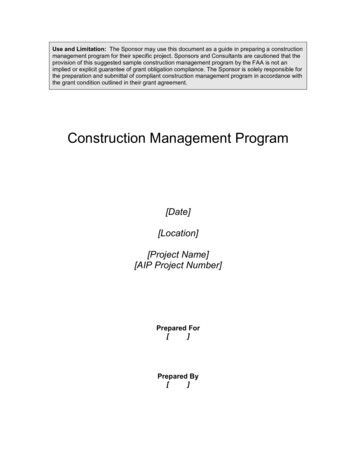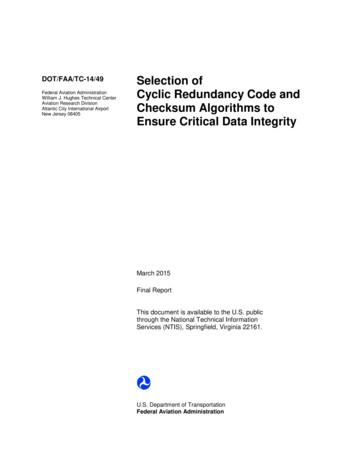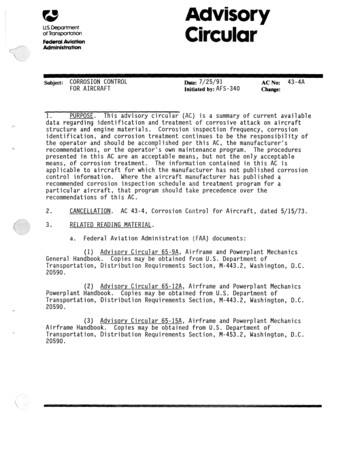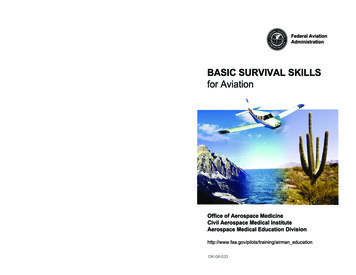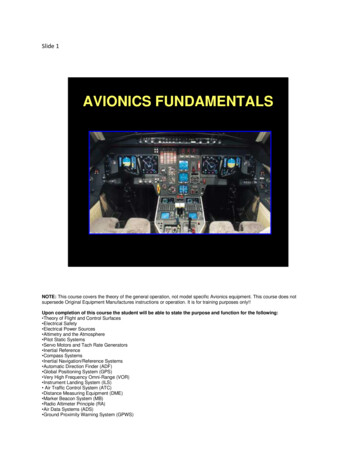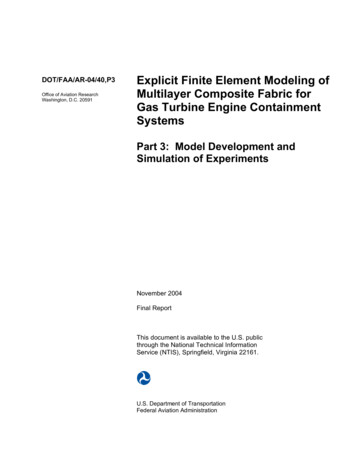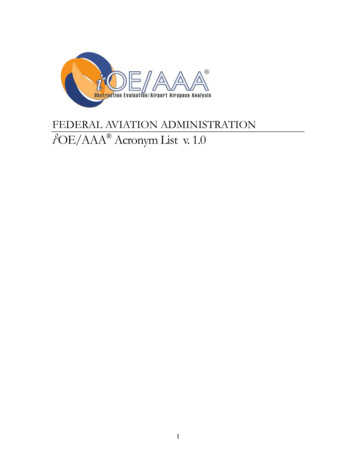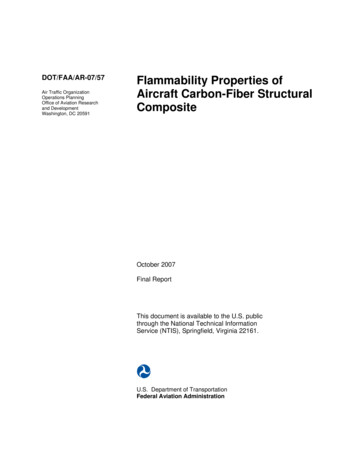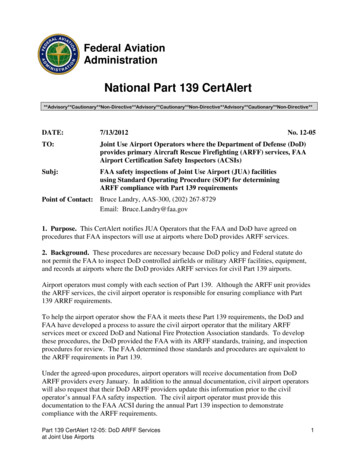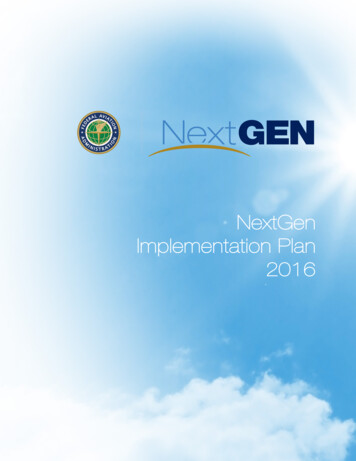
Transcription
NextGenImplementation Plan2016
June 2016Working in close collaboration with our aviation community partners, the FAAcompleted the majority of NextGen’s foundational infrastructure in 2015.Operators are already reaping benefits from the delivery of these programs,upon which we are continuing to build in 2016.We are pleased to provide you with the latest information on six of the programsthat are reshaping operations in the National Airspace System (NAS):From theAdministrator Automatic Dependent Surveillance–Broadcast (ADS-B)Data Communications (Data Comm)En Route Automation Modernization (ERAM)Terminal Automation Modernization and Replacement (TAMR)NAS Voice System (NVS)System Wide Information Management (SWIM)With the exception of NVS, which is still in the test and evaluation phase, eachof these programs is delivering benefits today while providing a platform foradditional capabilities that will provide even more benefits in the coming years.Timelines for new NextGen capabilities that are being developed and maturedthrough our implementation portfolio process are highlighted in the second halfof this report.Data Comm wrapped up operational trials in Memphis and Newark, and as ofthis writing, tower departure clearance services are now available at more than20 airports, including all of the New York area airports. Towers at a total of 56airports are expected to be equipped for Data Comm departure clearancesby the end of 2016 — 3 years ahead of schedule. Through our Equip 2020outreach effort, we have made tremendous strides in fostering ADS-B equipagewell in advance of the 1 January 2020 mandate. Since Equip 2020’s October2014 Call to Action, the number of ADS-B equipped aircraft has more thandoubled, and these numbers continue to grow.Many of these accomplishments could only have been achieved through closecollaboration with industry, and in late 2015 we released an update to theNextGen Joint Implementation Plan, which details our commitment to providethe capabilities in which the aviation community is most interested, in the areaswhere they are most needed.I trust you will find the 2016 NextGen Implementation Plan to be of value.Should you have any questions about the information reported in thisdocument, please contact me or Rachel Milberg, Acting Assistant Administratorfor Government and Industry Affairs, at (202) 267-3277.Sincerely,Michael P. HuertaAdministrator
CONTENTSPROGRAMS4914182225PORTFOLIOSAUTOMATIC DEPENDENTSURVEILLANCE–BROADCASTDATA COMMUNICATIONS32IMPROVED SURFACE OPERATIONS38IMPROVED APPROACHES ANDLOW-VISIBILITY OPERATIONSEN ROUTE AUTOMATIONMODERNIZATIONTERMINAL AUTOMATIONMODERNIZATION AND REPLACEMENT42IMPROVED MULTIPLE RUNWAYOPERATIONS49PERFORMANCE BASED NAVIGATION56TIME BASED FLOW MANAGEMENTNAS VOICE SYSTEMSYSTEM WIDE INFORMATIONMANAGEMENT61COLLABORATIVE AIR TRAFFICMANAGEMENT64SEPARATION MANAGEMENT68ON-DEMAND NAS INFORMATION71ENVIRONMENT AND ENERGY76SYSTEM SAFETY MANAGEMENT80NAS INFRASTRUCTUREAPPENDIX83APPENDIX: NEXTGEN FUNDING
NEXTGENPROGRAMSwww.faa.gov/nextgen 3
AUTOMATIC DEPENDENTSURVEILLANCE–BROADCASTAutomatic Dependent Surveillance–Broadcast (ADS-B) is thesuccessor to radar that uses onboard avionics to broadcast anaircraft’s position, altitude and velocity to a network of groundstations, which relays the information to air traffic controldisplays and to nearby aircraft equipped to receive the data viaADS-B In. ADS-B In provides operators of properly equippedaircraft with traffic position information delivered directly to thecockpit. Aircraft equipped with a Universal Access Transceiver(UAT) will also receive weather and Notices to Airmen(NOTAM) via the Flight Information Services–Broadcast(FIS-B) service.Aircraft operating in most controlled U.S. airspace — above10,000 feet mean sea level (MSL) or in Class B or C airspace— must be equipped for ADS-B Out by January 1, 2020.ADS-B In equipage is not currently mandated.TA R G E T U S E R S Aircraft owners and pilots flyingabove 10,000 feet MSL, within ClassC airspace, the airspace surroundingmost major airports or low altitudeairspace along the Gulf ofMexico coastline Air traffic controllers Airport surface vehicle operatorsE Q U I PA G E R E Q U I R E M E N T SAvionics equipment requirements for operatorsand installers are detailed in FAA AdvisoryCirculars AC 20-165B, AC 90-114A and AC20-172B, and Technical Standard OrdersTSO-C166b and TSO-C154c. To meet theADS-B Out mandate, aircraft require a positionsource, such as GPS, and a compatibletransmitter. A display device is needed forADS-B In. 4 NextGen Implementation Plan 2016Aircraft operating above 18,000 feet(FL180) or internationally require a ModeS transponder operating on 1090 MHzwith Extended Squitter (1090ES). A 1090MHz receiver is needed to process TrafficInformation Service–Broadcast (TIS-B)information. FIS-B is not available with1090 equipment.Aircraft operating within U.S. airspacebelow FL180 can use either a 1090ESor a UAT operating on 978 MHz. A UATis capable of receiving TIS-B and FIS-B.However, you need a receiver and displayto receive and view TIS-B andFIS-B information.
O P E R AT I O N A L C A PA B I L I T I E SADS-B Out avionics transmit position, groundspeed and other data to nearby aircraft equippedfor ADS-B In, and to ground receivers that provide the information to controllers. Additionalaircraft avionics are required for ADS-B In to receive and display data from ground stations andother aircraft.S E RV I C E C A PA B I L I T I E SADS-B In-equipped aircraft have access to the following additional broadcast services: FIS-B: On UAT, broadcasts graphical weather to the cockpit, as well as text-basedadvisories including NOTAMs, significant weather activity and pilot reports. TIS-B: Provides altitude, position and speed of aircraft flying in radar coverage and within a15-nautical mile (nm) radius — as far as or within 3,500 feet above or below the receivingaircraft’s position. Aircraft without ADS-B but equipped with transponders are tracked andbroadcast over the 1090ES and UAT frequencies to ADS-B In-equipped aircraft. Automatic Dependent Surveillance–Rebroadcast (ADS-R): ADS-B Out information can bebroadcast on two frequencies, 1090 MHz and 978 MHz. ADS-R rebroadcasts ground stationdata from one frequency to the other. It provides aircraft operating on on either ADS-B linkthe ability to see each other on their traffic displays when they are within 15 nm and 5,000feet above or below each other, and within range of ground stations.I M P L E M E N TAT I O NThe FAA completed baseline, nationwide deployment of ADS-B ground stations in 2014. ADS-Bhas been integrated into automation platforms at all 24 en route air traffic control facilities — 20En Route Automation Modernization systems and four Microprocessor En Route AutomatedRadar Tracking Systems (MEARTS) — which control high-altitude traffic. ADS-B has also beenintegrated into the automation platforms at the 30 busiest terminal areas, and is being deployedto all other terminal areas as their automation platforms are updated. ADS-B traffic and weatherbroadcasts are now available nationwide.www.faa.gov/nextgen 5
B E N E F I T S A C H I E V E D T O D AT E ADS-B has been tested successfully as a sole source of surveillance. Controllers can nowtrack aircraft during radar outages in controlled airspace. A new ADS-B In capability, Cockpit Display of Traffic Information – Assisted VisualSeparation, allows pilots to keep track of aircraft flying in front of them during a visualapproach to a runway. ADS-B is used to control traffic in areas such as the Gulf of Mexico where radar surveillanceis limited. Flights that used a special ADS-B route in the Gulf due to convective weatheror adverse headwinds saved 7-11 minutes of flight time on average, burned less fueland created fewer aircraft exhaust emissions than flights on traditional Area Navigationroutes. ADS-B-equipped helicopters servicing oil platforms in the Gulf may fly in visual andinstrument meteorological conditions under air traffic control. ADS-B allows direct routingclearances for properly equipped helicopters, which has shortened trips by about 14 nmand saved about 14 gallons of fuel per IFR flight. The FAA estimates flight savings of about350,000 nm from December 2009 to February 2015. Airport Surface Detection Equipment–Model X, a ground-surveillance system that alerts airtraffic controllers to potential runway and taxiway conflicts by using ADS-B and other datasources, reduces runway incursions and other ground operation accidents at 35 airportsthroughout the United States. Standards for a new ADS-B In capability, ADS-B Traffic Awareness System, were completedin 2014. This provides pilots with an audio alert to warn of other aircraft that might be acollision risk. General aviation pilots using UATs are receiving current weather and airspace statusinformation from the FAA’s free FIS-B service.6 NextGen Implementation Plan 2016
ADS-B COVERAGE ANDEN ROUTE INTEGRATIONAs of May 2016ADS-B integratedinto en routeautomationADS-B coverageareaRadio Stationwww.faa.gov/nextgen 7
PROGRAM MILESTONESADS-B Segment 1 and Segment 2 Investment DecisionSegment 1 Surveillance and Broadcast Services Interim Situation Displayfor ADS-BInitial Operating Capability (IOC) ADS-B Capability on Common AutomatedRadar Terminal System IIIE at New York TRACONIOC ADS-B Capability on Standard Terminal Automation Replacement Systemat Houston TRACONDATEAugust 2007September 2010July 2011March 2012IOC ERAM Release 3 with ADS-B Capability at Houston CenterApril 2012Flight TestingJune 2013Achieve En Route Separation Services IOC at the 12th siteAchieve 12 of 16 Remote Units sending Airport Service Surveillance Capabilitydata to Air Traffic Control Tower equipment at SFOAchievement of critical Services Implementation Service Acceptance Test at all306 Service Volumes (Services encompass ADS-B Out, ADS-B In,TIS-B, FIS-B)Complete baseline ADS-B radio station infrastructure deploymentAchieve Terminal Separation Services IOC at the 55th siteComplete IOC Surface Advisory Services at all 35 Airport Surface DetectionEquipment–Model X sitesInvestment Analysis Readiness Decision for ADS-B In ApplicationsPlanning MilestonesMEARTS Fusion Processing for 5 nm Separation Services IOC at ZANComplete IOC at last (24th) En Route siteOceanic In-Trail Procedures operational at OaklandExpansion of Gulf of Mexico ADS-B coverageFinal Investment Decision for ADS-B In Applications Planning MilestoneComplete all Terminal and Surface IOCsADS-B Out Rule Compliance (aircraft equipage deadline)8 NextGen Implementation Plan 2016March 2014March 2014March 2014March 2014June 2014September 2014June 2015August 2015September 2015August 2016September 2016October 20172019January 1, 2020
DATA COMMUNICATIONSData Communications (Data Comm) enables controllers andpilots to communicate with digitally delivered messages, ratherthan rely solely on radio voice communications. With thepush of a button, controllers can electronically send routineinstructions, such as departure clearances and weatheravoiding reroutes, directly to the flight deck. Messages appearonly on the cockpit display of the aircraft to which they apply,reducing the potential for miscommunication that can occurfrom radio voice exchanges.TA R G E T U S E R S Air traffic controllers Airline pilots Airline dispatchersE Q U I PA G E R E Q U I R E M E N T SFuture Air Navigation System 1/AVHF Digital Link Mode 2 avionics foren route servicesVHF Digital Link Mode 0 avionics will beaccommodated for tower servicesO P E R AT I O N A L C A PA B I L I T I E S Data Comm is initially delivering digital tower departure clearance services, includingroute revisions. Data Comm services will be implemented in en route airspace, enabling controllers to providepilots with frequency handoffs, altitude changes and inflight reroutes. Pilots can also senddigital messages to controllers. Collectively, these services will save time, increase controller and pilot productivity, andreduce the potential for miscommunication as controllers send digital messages to eachaircraft. These improvements enable greater efficiency, improved routing around weather andcongestion, and increased flexibility and accommodation of user requests.I M P L E M E N TAT I O NTower trials at Memphis and Newark finished in January 2016. The FAA achieved InitialOperating Capability (IOC) for Data Comm tower services at Salt Lake City, Houston Bush,Houston Hobby, New Orleans, Louisville, New York John F. Kennedy, Newark, San Antonio andAustin airports. The remaining tower deployments at 47 airports are planned for 2016–2019.In late 2014, the FAA made the final investment decision and baselined initial en route services.Initial Data Comm capabilities are expected in high-altitude airspace beginning in 2019. TheFAA expects to achieve IOC at all 20 en route centers in the continental United States by 2021.The FAA is providing incentive money for operators to equip with Data Comm on the flightdecks of 1,900 aircraft by 2019. Under the incentive program, eight airlines have agreed to addData Comm avionics, with the first aircraft being equipped in 2014.www.faa.gov/nextgen 9
No deployment is currently planned for Terminal Radar Approach Control facilities, which controltraffic arriving at and departing from our nation’s airports. Advanced trajectory services are still inconcept phase.B E N E F I T S A C H I E V E D T O D AT EPreliminary qualitative benefits seen during trials in Memphis and Newark include reducedcommunications time, resulting in faster taxi-outs, reduced delays and reduced pilot andcontroller workload.DATA COMMUNICATIONSDEPARTURE CLEARANCETOWER SERVICEAs of May 2016Tower DCL Sites (56 Airports)Operational SitesScheduled Sites10 NextGen Implementation Plan 2016
PROGRAM MILESTONESDATESEGMENT 1Data Comm Segment 1 Phase 1 Final Investment Decision (FID) for En RouteAutomation Modernization (ERAM) and Tower Data Link System (TDLS)Data Comm Segment 1 Phase 1 Data Comm Integrated ServicesContract AwardData Comm Segment 1 Phase 1 TDLS Preliminary Design Review completeData Comm Segment 1 Phase 1 TDLS Critical Design Review completeComplete Program Level Integrated Baseline ReviewMay 2012September 2012October 2012July 2013February 2014Deliver Data Comm Network Service Build 1 to William J. HughesTechnical CenterMarch 2014Data Comm Segment 1 Phase 1 ERAM Initial Test Release (ITR)April 2014TDLS V12 ITRApril 2014Complete Data Comm Informal Integration and Interface Service TestJuly 2014Data Comm Segment 1 Phase 1 Operational Test and EvaluationMarch 2015Data Comm Segment 1 Phase 1 DCL Tower Services IOC at key site(Salt Lake City)August 2015IOC at Houston Hobby (HOU) and Houston Bush (IAH)September 2015Data Comm Segment 1 Phase 1 Site Operational Readiness DemonstrationSeptember 2015Data Comm Segment 1 Phase 1 In-Service Decision (ISD)December 2015Data Comm Segment 1 Phase 1 IOC at last siteMay 2019SEGMENT 1 PHASE 2Data Comm Segment 1 Phase 2 Initial En Route Services FIDData Comm Segment 1 Phase 2 Full En Route Services FIDOctober 2014December 2016Data Comm Segment 1 Phase 2 Development Test and Evaluation CompleteJune 2018Data Comm Segment 1 Phase 2 IOC at first siteJuly 2019Data Comm Segment 1 Phase 2 ISDMarch 2020Data Comm Segment 1 Phase 2 IOC at last siteFebruary 2021TOWER TRIALSInitiate Departure Clearance (DCL) tower trials at MEMInitiate DCL tower trials at EWRComplete DCL tower trialsJanuary 2013April 2013January 2016www.faa.gov/nextgen 11
D E PA RT U R E C L E A R A N C E T O W E R S E RV I C E S C H A L L E N G E M I L E S T O N E SThe NextGen Priorities Joint Implementation Plan commits the FAA to begin delivering departureclearances at 56 airports under the Data Comm program’s Segment 1 Phase 1. The baselinecalls for this work to be completed by the end of 2019 but the agency is working toward challengedates that would have services at all 56 locations in place by the end of 2016 (see chart below forspecifics). The order of the towers may move within the groups based on operational requirements;however, the FAA and industry will work together to manage these changes.SITE NAMEKEYSITE (3 TOWERS)SITE IDARTCC IDIOC (CY)KS 1: Salt Lake CitySLCZLCQ2 2015KS 2: Houston BushIAHZHUQ3 2015KS 3: Houston HobbyHOUZHUQ3 2015SITE NAMENew OrleansAustinSan AntonioLos AngelesLas VegasSan DiegoJohn WayneBob HopeOntarioSan FranciscoOaklandSan las LoveDallas/Fort Worth (x2)12 NextGen Implementation Plan 2016GROUP A (19 TOWERS)SITE IDARTCC BZABZSEZSEZFWZFWIOC (CY)Q1 2016Q1 2016Q1 2016Q1 2016Q1 2016Q2 2016Q2 2016Q2 2016Q2 2016Q2 2016Q2 2016Q3 2016Q3 2016Q3 2016Q3 2016Q3 2016Q3 2016Q4 2016Q4 2016
SITE lantaCharlotteJacksonvilleOrlandoMiamiFort LauderdaleTampaPalm BeachSt. LouisKansas CityMinneapolis-St. PaulSITE NAMENewarkNew York John F. KennedyNew York WashingtonWashington DullesWashington ReaganRaleigh-DurhamChicago MidwayChicago O’HareGROUP B (17 TOWERS)SITE IDARTCC OUP C (18 TOWERS)SITE IDARTCC CZDCZAUZAUIOC (CY)Q1 2016Q1 2016Q2 2016Q2 2016Q2 2016Q2 2016Q2 2016Q2 2016Q3 2016Q3 2016Q3 2016Q3 2016Q3 2016Q4 2016Q3 2016Q4 2016IOC (CY)Q1 2016Q1 2016Q1 2016Q1 2016Q2 2016Q2 2016Q2 2016Q2 2016Q2 2016Q3 2016Q3 2016Q3 2016Q3 2016Q3 2016Q3 2016Q4 2016Q4 2016Q4 2016www.faa.gov/nextgen 13
EN ROUTE AUTOMATIONMODERNIZATIONEn Route Automation Modernization (ERAM) is one of thefoundational programs of NextGen. It is a more capable andflexible platform than the decades-old HOST legacy system itreplaces. ERAM is now online at the 20 en route traffic controlcenters in the contiguous United States. It performs corefunctions at the FAA centers where high-altitude air traffic iscontrolled. ERAM processes flight and surveillance radar data,enables efficient controller-pilot communications and generatesdetailed display data to air traffic controllers. It covers themajority of the nation’s continental airspace — more than3.2 million square miles — and controls more than 30 millionflights annually. It serves as the platform upon which NextGenprograms such as data sharing, digital communications andtrajectory-based operations reside.TA R G E T U S E R S Air traffic controllers aten route centersE Q U I PA G E R E Q U I R E M E N T SAdditional equipage not required forNational Airspace System (NAS) usersO P E R AT I O N A L C A PA B I L I T I E S ERAM combines flight plan information with surveillance data from Automatic DependentSurveillance–Broadcast (ADS-B), Wide Area Multilateration and radar to automate a numberof air traffic control functions such as tracking aircraft, providing conflict alerts and minimumsafe altitude warnings, and recording air traffic events. ERAM enables controllers to see beyond the boundaries of the airspace controlled by theirown center, enabling them to handle traffic more efficiently. Each ERAM system can track 1,900 aircraft at a time, compared with 1,100 for the HOSTlegacy system.I M P L E M E N TAT I O NIn March 2015, the 20 planned ERAM sites achieved operational readiness, which signified thefull commissioning of ERAM into the NAS and allowed the FAA to begin decommissioning thelegacy HOST system. Other air traffic facilities and government agencies are now connectedto the centers via ERAM. In addition to Terminal Radar Approach Control facilities, thisincludes airport towers, the FAA Command Center and automated flight service stations, U.S.Department of Homeland Security, DoD, a
NextGen Joint Implementation Plan, which details our commitment to provide the capabilities in which the aviation community is most interested, in the areas where they are most needed. I trust you will find the 2016

